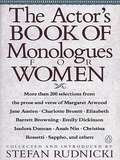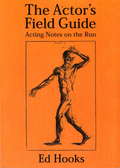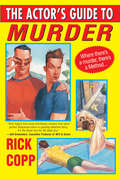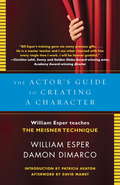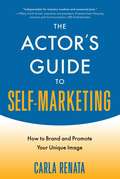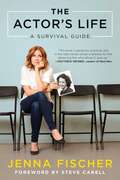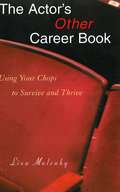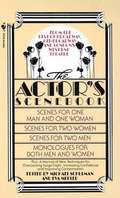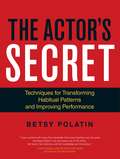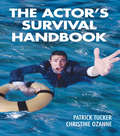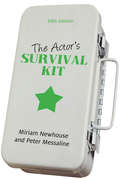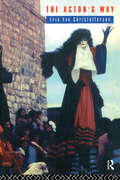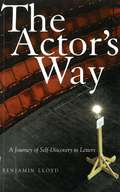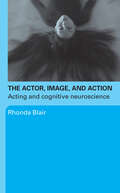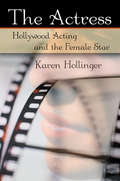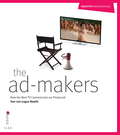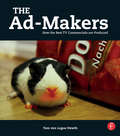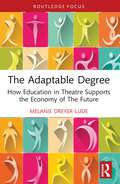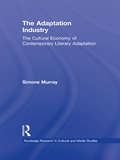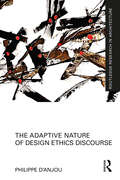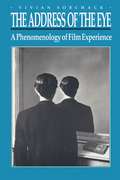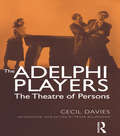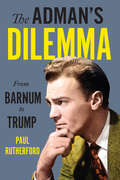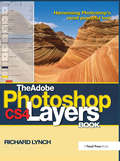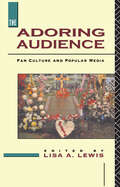- Table View
- List View
The Actor's Book of Monologues for Women
by VariousA diverse collection of monologues featuring the voices of women through the ages Drawn from poetry, fiction, diaries, journals, and documents of public record, these selections, although not originally intended for theatrical or cinematic performances, offer unique dramatic opportunities for actors, speakers, students, or anyone interested in women’s studies. Stefan Rudnicki has brought together selections from well-known as well as obscure authors, providing a tremendous range of women’s perspectives from a variety of sources: poems by Elizabeth Barrett Browning, Emily Dickinson, Christina Rossetti, and Sappho, among others; passages from Mary Shelley’s journal, the diaries of Anais Nin, and the memoirs of Isadora Duncan; polemics from Mary Wollstonecraft and Joan of Arc, as well as Susan B. Anthony’s “On Woman’s Right to Suffrage”; and selections from the novels of Emily and Charlotte Bronte, Jane Austen, Ursula K. LeGuin, and others.
The Actor's Field Guide
by Ed HooksFrom a veteran actor, teacher, and author, here is a quick-reference guide aimed at working actors. Got a funny scene that doesn't seem very funny? Look up "comedy." Got a scene in which you're supposed to cry? Look up "cry." Each entry includes a brief introduction to the topic, followed by several pages of short, bulleted tips or "field notes" that offer quick solutions to any acting problem. In addition, there are brief essays throughout that expand on some of the trickier aspects of the actor's craft. Edgy, concise, and infinitely helpful, no working actor will want to be without this one-of-a-kind guide.* There are 100,000 members in actors unions in the US, with a 50% turnover* Unique quick reference guide for busy actors* Advice on everything from rehersals to auditioning and memorizing lines* Author has trained thousands of actors, including Heather Locklear and Teri Hatcher* Advertising in Back Stage magazineFrom the Trade Paperback edition.
The Actor's Guide To Murder
by Rick Copp"Baby, don't even go there!" That was Jarrod Jarvis's catch phrase as the adorable, girl-crazy moppet on the eighties sitcom, Go To Your Room! It was a great ride until the tabloids caught the popular teen idol kissing another guy at the L. A. gay rodeo. "Gay" and "teen heartthrob" not exactly being career-making words at the time, Jarrod's star crashed harder than a Kathie Lee Gifford CD. Flash forward: Now happily living with his cop boyfriend, Charlie, and their dog, Snickers, in the Hollywood Hills, Jarrod's ready to hit the comeback trail. . . but he never imagines how fame will strike this time. At a reading with his psychic, Jarrod is disturbed to hear that someone close to him will be murdered and even more shocked when it turns out to be his best friend, Willard Ray Hornsby, also a former child star. When Willard is found face down in his own lap pool, the cops call it an accident, but Jarrod's far from convinced--and he's ready to play the Sherlock Holmes of West Hollywood to prove his conspiracy theory right. . . "Fast-paced and very funny, with a hip insider's view of Hollywood. The Actor's Guide to Murder is the reader's guide to a terrific time. I loved it. " --Laura Levine, author of Last Writes "A pumped-up, promising debut. . . the story has considerable zest and enough sprightly humor to keep readers glued and giggling. " --Publishers Weekly "I laughed all the way through The Actor's Guide to Murder. Here's hoping Jarrod stumbles across another dead body, and soon!" --Dean James, author of Decorated to Death "Rick Copp's Actor's Guide mysteries read like some hilariously wicked Lifestyles of the Rich and Infamous--revealing juicy Hollywood secrets by the page!" --Jerrilyn Farmer, author of Mumbo Gumbo
The Actor's Guide to Creating a Character: William Esper Teaches the Meisner Technique
by David Mamet Patricia Heaton William Esper Damon DimarcoWilliam Esper, one of the most celebrated acting teachers of our time, takes us through his step-by-step approach to the central challenge of advanced acting work: creating and playing a character. Esper's first book, The Actor's Art and Craft, earned praise for describing the basics taught in his famous first-year acting class. The Actor's Guide to Creating a Character continues the journey. In these pages, co-author Damon DiMarco vividly re-creates Esper's second-year course, again through the experiences of a fictional class. Esper's training builds on Sanford Meisner's legendary exercises, a world-renowned technique that Esper further developed through his long association with Meisner and the decades he has spent training a host of distinguished actors. His approach is flexible enough to apply to any role, helping actors to create characters with truthful and compelling inner lives.
The Actor's Guide to Self-Marketing: How to Brand and Promote Your Unique Image
by Carla RenataStand Out from the Competition! How do actors sell their personality? What does it take to make a lasting impression? How can actors use their image to achieve their dreams? The Actor's Guide to Self-Marketing answers all these questions and more. With a background in acting and publicity, author Carla Renata has gathered insider info and proven tips to help actors create their own brand and utilize it for success. With The Actor's Guide to Self-Marketing, you will learn how to: Highlight unique traits and skills Distinguish yourself from the crowd Market yourself through social media Angle for your dream role And so much more! Renata's methods have been tested and developed through her branding and social media program, The Branding Buddha, which has been taught online and privately, as well as in group classes at top universities in the United States. Along with tips from her program and extensive background in the field, Renata uses meditative practices and self-actualization to help actors develop their public image and reach their goals with clarity and intention. As she writes, "The mind is everything. What you think, you will become." With The Actor's Guide to Self-Marketing, you'll be well on your way to becoming the actor you really want to be and landing your dream roles.
The Actor's Life: A Survival Guide
by Jenna FischerJenna Fischer's Hollywood journey began at the age of 22 when she moved to Los Angeles from her hometown of St. Louis. With a theater degree in hand, she was determined, she was confident, she was ready to work hard. So, what could go wrong? Uh, basically everything. The path to being a professional actor was so much more vast and competitive than she'd imagined. It would be eight long years before she landed her iconic role on The Office, nearly a decade of frustration, struggle, rejection and doubt. If only she'd had a handbook for the aspiring actor. Or, better yet, someone to show her the way—an established actor who could educate her about the business, manage her expectations, and reassure her in those moments of despair. Jenna wants to be that person for you. With amusing candor and wit, Fischer spells out the nuts and bolts of getting established in the profession, based on her own memorable and hilarious experiences. She tells you how to get the right headshot, what to look for in representation, and the importance of joining forces with other like-minded artists and creating your own work—invaluable advice personally acquired from her many years of struggle. She provides helpful hints on how to be gutsy and take risks, the tricks to good auditioning and callbacks, and how not to fall for certain scams (auditions in a guy's apartment are probably not legit—or at least not for the kind of part you're looking for!). Her inspiring, helpful guidance feels like a trusted friend who's made the journey, and has now returned to walk beside you, pointing out the pitfalls as you blaze your own path towards the life of a professional actor.
The Actor's Other Career Book: Using Your Chops to Survive and Thrive
by Lisa MulcahyActors don't have to become Broadway stars to make a living with their acting talents. The Actor's Other Career Book pulls back the curtain to reveal more than 50 permanent and temporary positions available in cruise ships, trade shows, retail stores, advertising agencies, corporate settings, education, social outreach, tourist attractions, physical fitness, and much more. Whether actors are looking to continue performing in new venues or apply their skills to a new field, this is the resource to help make the transition. Interviews with successful actors reveal how others looked beyond the stage for lucrative and satisfying work, how they applied their training and background to their current positions, and how they achieved success on their own terms. A comprehensive listing of organizations, Web sites, companies, and publications provide a wealth of tools. All actors looking to take control of their futures will need this book.
The Actor's Scenebook
by Michael Schulman Eva MeklerHere is wonderful, up-to-date material for scene study, selected from the best plays from recent theater seasons. More than 20 monologues for both men and women, carefully chosen to display the widest range of dramatic ability, are essential for auditioning actors. A large selection of parts for woman provide exciting opportunities to sharpen acting skills in roles that brought accolades from New York's toughest critics. More than 80 scenes in all, many previously unpublished, allow every actor, professional, amateur or student, to choose from either smart, sassy, often outrageous comedy or deeply moving drama--a unique, balanced collection of the most successful contemporary plays. 84 fully playable scenes with story notes. Monologues from the best new plays--including Agnes of God, Sly Fox, Key Exchange and Nuts. The best contemporary selection of scenes for women--more than 50 in all.
The Actor's Secret: Techniques for Transforming Habitual Patterns and Improving Performance
by Betsy PolatinOffering revolutionary new training for the actor, The Actor's Secret teaches actors and performers how to incorporate the fundamentals of the Alexander Technique, Somatic Experiencing®, and Breathing Coordination in order to reduce performance anxiety and stress; improve stage presence, breathing, and vocal production; and restore well-being and healthy functioning. These three kinesthetic disciplines are designed to lead to profound change and healing through body-mind reeducation. Part I explains in detail the principles of the three techniques. A practical method for self-improvement and neuromuscular reeducation, the Alexander Technique focuses on changing inefficient habits of movement and patterns of tension that inhibit the ability to move easily. Breathing Coordination helps increase breathing capacity and awareness. A method for resolving emotional trauma, Somatic Experiencing® follows a process of tracking bodily sensations to restore vitality and health. Enhanced with over 100 instructive photos, Parts II and III present explorations and exercises that draw on elements of the three methods. Topics covered include the importance of presence and non-doing; the proper mechanics of vocalization and singing; the understanding of character and role; and the actor's journey from auditions to performance, including initial script preparation, rehearsal, monologue, and scene work. Developed by Betsy Polatin, a movement specialist and master lecturer at Boston University's College of Fine Arts, the book's exercises provide the actor with simple tools for exploring his or her acting work. Most techniques and self-help books teach a new way of "doing." The secret of this book lies in "non-doing." When the actor learns to first recognize and then suspend habitual patterns, he or she opens the door to deeper artistic choices. "I have worked with many fine Alexander Technique teachers over the years and Betsy Polatin is far and away one of the finest. Her touch, her instincts, and her knowledge are miraculous."--Andre Gregory, actor and director, My Dinner with Andre
The Actor's Survival Handbook
by Patrick Tucker Christine OzanneWorried about short rehearsal time? Think that fluffing your lines will be the end of your career? Are you afraid you'll be typecast? Is there such a thing as acting too much? How should a stage actor adjust performance for a camera? And how should an actor behave backstage?The Actor's Survival Handbook gives you answers to all these questions and many more. Written with verve and humor, this utterly essential tool speaks to every actor's deepest concerns. Drawing upon their years of experience on stage, backstage, and with the camera, Patrick Tucker and Christine Ozanne offer forthright advice on topics from breathing to props, commitment to learning lines, audience response to simply landing the job in the first place. The book is rich with examples - both technical and inspirational. And because a director and an actor won't always agree, the two writers sometimes even offer alternative responses to a dilemma, giving the reader both an actor's take and a director's take on a particular point.Like Patrick Tucker's Secrets of Screen Acting, this new book is written with wit and passion, conveying the authors' powerful conviction that success is within every actor's grasp.
The Actor's Survival Kit: Fifth Edition
by Miriam Newhouse Peter MessalineThe Actor’s Survival Kit is required reading in Canadian theatre schools and is a constant resource for its many readers across the country. This fifth edition gives actors fresh research from today’s experience, new lists of Canada-wide contacts, and input from success stories. It speaks to a new generation of artists, giving them an up-to-date guide to the business of acting. The book addresses a range of new issues: performer websites, video self-production, and sending rmand networking on the Internet. It also takes a fresh look at old ones: agents, self-promotion, and work opportunities for women and minorities. The authors learn by constantly talking to emerging artists about the problems they face in the business in Canada. Often those conversations begin with, "You wrote the book!" The authors are still receiving thanks from grateful artists who have been guided by this irreplaceable book over the years.
The Actor's Way
by Erik Exe ChristoffersenCan 'stage presence' be acquired? Why do some actors appear more dynamic in performance than others? In The Actors Way four experienced actors talk about the secrets and the practical realities of over twenty-five years of theatre training with Odin Teatret. Under the unique direction of Eugenio Barba, director of Odin Teatret, they have explored issues such as the connections between physical and mental work on stage, how to gain and control the spectator's attention, and intercultural performance techniques. The Actor's Way is a fascinating account of personal and professional development in the theatre. It will be vital reading for drama students and actors, but enjoyable and illuminating for anyone interested in the craft of acting.
The Actor's Way: A Journey of Self-Discovery in Letters
by Benjamin LloydThis is required reading for anyone passionate about the theater, acting, and the teaching of it. The struggles of a young actor, the actor/director relationship, the challenges of teaching art in universities, ageism, and techniques for teaching realistic acting are all communicated through a fictional series of letters between Andy, an anguished young New York City actor and Alice, his Quaker grade-school acting teacher.
The Actor, Image, and Action: Acting and Cognitive Neuroscience
by Rhonda BlairThe Actor, Image and Action is a 'new generation' approach to the craft of acting; the first full-length study of actor training using the insights of cognitive neuroscience. In a brilliant reassessment of both the practice and theory of acting, Rhonda Blair examines the physiological relationship between bodily action and emotional experience. In doing so she provides the latest step in Stanislavsky's attempts to help the actor 'reach the unconscious by conscious means'. Recent developments in scientific thinking about the connections between biology and cognition require new ways of understanding many elements of human activity, including: imagination emotion memory physicality reason. The Actor, Image and Action looks at how these are in fact inseparable in the brain's structure and function, and their crucial importance to an actor’s engagement with a role. The book vastly improves our understanding of the actor's process and is a must for any actor or student of acting.
The Actress: Hollywood Acting and the Female Star
by Karen HollingerThe Actress: Hollywood Acting and the Female Star investigates the contemporary film actress both as an artist and as an ideological construct. Divided into two sections, The Actress first examines the major issues in studying film acting, stardom, and the Hollywood actress. Combining theories of screen acting and of film stardom, The Actress presents a synthesis of methodologies and offers the student and scholar a new approach to these two subjects of study.
The Ad Makers: How the Best TV Commercials are Produced
by Tom von NewthThe Ad-Makers looks at the cinematic form where commerce and creativity collide most dramatically: the TV commercial.Featuring interviews from top professionals in the field, the book provides the kind of behind-the-scenes expertise that it usually takes a lifetime of professional practice to acquire.Gathered from the disciplines of cinematography, directing, producing and editing, the filmmakers tell the stories behind the making of some of the world's top commercials. Each chapter includes an overview of best practice and a host of images-stills from the spots themselves and concept visuals.Exploring the creative process from conception to post-production, The Ad-Makers also covers developments within the industry precipitated by the digital age and the new challenges placed on ad-making by the explosion of social media.With special focus on the shooting and production elements of making a television advert, this book is ideal for all filmmakers who want to build a career in advertising, or, as is increasingly common, feature films.- The stories behind some of the best-known TV commercials, as told by the people who made them- Top producers, designers, storyboarders, directors, editors and visual effects creatives reveal the secrets of the television advertising industry
The Ad-Makers: How the Best TV Commercials are Produced (Creative Professional Ser.)
by Tom von Logue NewthThe Ad-Makers looks at the cinematic form where commerce and creativity collide most dramatically: the TV commercial. Featuring interviews from top professionals in the field, the book provides the kind of behind-the-scenes expertise that it usually takes a lifetime of professional practice to acquire. Gathered from the disciplines of cinematography, directing, producing, and editing, the filmmakers tell the stories behind the making of some of the world’s top commercials. Each chapter includes an overview of best practice and a host of images—stills from the spots themselves and concept visuals. Exploring the creative process from conception to post-production, The Ad-Makers also covers developments within the industry precipitated by the digital age and the new challenges placed on ad-making by the explosion of social media. With special focus on the shooting and production elements of making a television advert, this book is ideal for all filmmakers who want to build a career in advertising or even feature films. • The stories behind some of the best-known TV commercials, as told by the people who made them • Top producers, designers, storyboarders, directors, editors, and visual effects creatives reveal the secrets of the television advertising industry
The Adaptable Degree: How Education in Theatre Supports the Economy of The Future (ISSN)
by Melanie Dreyer-LudeThis book utilized a mixed-methods research study of the career experiences of theatre graduates in the U.S. to provide data on employment patterns and job satisfaction.With a population of over 1,000 participants, this study examined where graduates were working, how their careers had changed over time, which skills acquired with their theatre degree were being used in current employment, and whether they believed their course of study was worth the financial investment, given their current circumstances. Evidence from this study revealed that a theatre degree provided many of the skills the employment market is currently seeking and that theatre graduates were gainfully employed in multiple sectors of the economy.This important data-based, field-specific information will aid chairs, deans, provosts, politicians, students and parents in deicision-making at a time when arts and humanities departments across the country are under the threat of elimination.
The Adaptation Industry: The Cultural Economy of Contemporary Literary Adaptation (Routledge Research in Cultural and Media Studies)
by Simone MurrayAdaptation constitutes the driving force of contemporary culture, with stories adapted across an array of media formats. However, adaptation studies has been concerned almost exclusively with textual analysis, in particular with compare-and-contrast studies of individual novel and film pairings. This has left almost completely unexamined crucial questions of how adaptations come to be made, what are the industries with the greatest stake in making them, and who the decision-makers are in the adaptation process. The Adaptation Industry re-imagines adaptation not as an abstract process, but as a material industry. It presents the adaptation industry as a cultural economy of six interlocking institutions, stakeholders and decision-makers all engaged in the actual business of adapting texts: authors; agents; publishers; book prize committees; scriptwriters; and screen producers and distributors. Through trading in intellectual property rights to cultural works, these six nodal points in the adaptation network are tightly interlinked, with success for one party potentially auguring for success in other spheres. But marked rivalries between these institutional forces also exist, with competition characterizing every aspect of the adaptation process. This book constructs an overdue sociology of contemporary literary adaptation, never losing sight of the material and institutional dimensions of this powerful process.
The Adaptive Nature of Design Ethics Discourse (Routledge Research in Architecture)
by Philippe d’AnjouHow do designers navigate the ethical discursive territories of design thinking and practice when the same common terms they consistently use across the different design ethics paradigms—like fair, right, good—convey different meanings? Delving into the dynamic and adaptable nature of ethical language and terminology in design, The Adaptive Nature of Design Ethics Discourse argues that it is intrinsically flexible—what can be described as chameleonic. Engaging in a meta-ethical investigation, this book elucidates the interconnections of key terms of design ethics discourse and explores the way in which different frameworks of design ethics both diverge and intersect.The book challenges existing perspectives on ethical discourse in design by highlighting the complexities of such discourse and the tensions that emerge when universal language encounters various ethical views. By shedding light on these tensions, The Adaptive Nature of Design Ethics Discourse provides alternative ways to apprehend the ethical sense of responsibility of designers as well as a foundation for rethinking the discursive fabric of design ethics practice.This pivotal work is intended for researchers, educators, students, and practitioners across all design disciplines, including, among others, architecture, engineering, product design, systems design, and urban planning.
The Address of the Eye: A Phenomenology of Film Experience
by Vivian SobchackCinema is a sensuous object, but in our presence it becomes also a sensing, sensual, sense-making subject. Thus argues Vivian Sobchack as she challenges basic assumptions of current film theory that reduce film to an object of vision and the spectator to a victim of a deterministic cinematic apparatus. Maintaining that these premises ignore the material and cultural-historical situations of both the spectator and the film, the author makes the radical proposal that the cinematic experience depends on two "viewers" viewing: the spectator and the film, each existing as both subject and object of vision. Drawing on existential and semiotic phenomenology, and particularly on the work of Merleau-Ponty, Sobchack shows how the film experience provides empirical insight into the reversible, dialectical, and signifying nature of that embodied vision we each live daily as both "mine" and "another's." In this attempt to account for cinematic intelligibility and signification, the author explores the possibility of human choice and expressive freedom within the bounds of history and culture.
The Adelphi Players: The Theatre of Persons
by Dr Cecil DaviesCecil Davies' The Adelphi Players: The Theatre of Persons represents a uniquely interesting contribution to our understanding of touring British theatre in the mid-twentieth-century, post-war period. This book will interest everyone - whether student, academic or general reader - who wants to know more about issues concerning the recent history of British theatre. In their values and aims, the Adelphi Players pre-empted many of the post-war developments that we associate with the non-commercial, fringe and community theatre movement. In Richard Heron Ward founder of the Adelphi-Players, we encounter a dramatist, novelist, essayist and poet who has been unusually neglected in terms of our appreciation of the English literature of the broad left in the 1930s, `40s and `50s. The Adelphi Players has been edited by Peter Billingham, who has also provided an introduction placing Ward and the Adelphi players in the wider social, cultural and ideological context.
The Adman’s Dilemma: From Barnum to Trump
by Paul RutherfordThe Adman’s Dilemma is a cultural biography that explores the rise and fall of the advertising man as a figure who became effectively a licensed deceiver in the process of governing the lives of American consumers. Apparently this personage was caught up in a contradiction, both compelled to deceive yet supposed to tell the truth. It was this moral condition and its consequences that made the adman so interesting to critics, novelists, and eventually filmmakers. The biography tracks his saga from its origins in the exaggerated doings of P.T. Barnum, the emergence of a new profession in the 1920s, the heyday of the adman’s influence during the post-WW2 era, the later rebranding of the adman as artist, until the apparent demise of the figure, symbolized by the triumph of that consummate huckster, Donald Trump. In The Adman’s Dilemma, author Paul Rutherford explores how people inside and outside the advertising industry have understood the conflict between artifice and authenticity. The book employs a range of fictional and nonfictional sources, including memoirs, novels, movies, TV shows, websites, and museum exhibits to suggest how the adman embodied some of the strange realities of modernity.
The Adobe Photoshop CS4 Layers Book: Harnessing Photoshop's most powerful tool
by Richard LynchMasterPhotoshop CS4 with this visual, hands-on guide to using layers, under the expert guidance of digital imaging specialist Richard Lynch. Layers, Photoshop's most powerful feature, is the core of a nondestructive image-editing workflow.Step-by-step instructions and practical examples illustrate how to. Polish: correct and enhance color, fix composition problems, and repair damage or flaws Manipulate: isolate image areas for changes, adjustments and experimental concepts Understand: use all forms of layer blending, including transparency, clipping masks, opacity/fill, layer masks, layer modes, channel targeting, Blend If, and Effects/Styles. The accompanying downloadable resources come complete with a generous library of practical actions based on techniques from the book that add functional power to Photoshop, along with practice images for all the exercises in the book. This focused, highly accurate, comprehensive, and practical guide offers invaluable advice for all users of Adobe Photoshop CS4.
The Adoring Audience: Fan Culture and Popular Media
by Lisa A. LewisWith stories of hysterical teenagers and obsessive fans killing for their heroes, fans and fandom get a bad press. The Adoring Audience looks deeper into fan culture, particularly as it relates to identity, sexuality and textual production.
